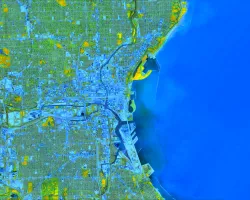Since ARSET began broadcasting online trainings in 2011, webinars focused on users with limited remote sensing experience. All advanced trainings took place at in-person workshops, which have a limited capacity and typically focus on region-specific needs. In response to the high demand for in-depth instruction, ARSET offered its first advanced online series in October 2015.
Aerosol Optical Depth: Particulate Matter
Dr. Pawan Gupta of NASA GSFC hosted “Satellite Remote Sensing of Particulate Matter Air Quality: Data, Tools, Methods, and Applications,” with one hour sessions each week between October 1-29. The series began with the fundamentals of particulate matter and aerosol optical depth, along with simple methods and tools to read satellite data. Guest speakers Dr. Yang Liu (Emory University) and Dr. Randall Martin (Dalhousie University) covered two different methods of estimating particulate matter at surface level: a statistical method, and a method combining satellite observations with a chemical transport model.
The resources presented were useful for training participants all over the globe. One attendee wrote, “I cannot analyse the PM 2.5 concentrations in the remote area where there is no road connectivity and electricity. Further, we have very few ground monitoring stations in our country. The training program was very helpful in providing the tools and data for such areas.”
The available satellite resources opened options for one participant, who said the training “motivated me to use satellite-based information for air quality management. So far I was dependent on ground-based tools like monitoring, inventory, and modeling.”
Virtual Conference
In another ARSET first, a virtual conference at the end of the series allowed participants to present projects completed by applying the data, tools, and methods covered in the training. Attendees self-formed into teams using the webinar’s live chat function. Many groups formed based on geographic locations, including Latin America, India, Pakistan, and California. On November 20, 12 teams presented projects.
The presentations covered a range of air quality topics including ground-level PM2.5 concentrations in Karachi, Pakistan; Saharan dust impacting the Gulf region; analysis of smoke transport towards Cordoba, Argentina, during a biomass burning event; and understanding PM2.5 trends in the San Joaquin Valley, California, for 1999-2014.
To view the recordings from this webinar series visit: https://arset.gsfc.nasa.gov/airquality/webinars.


